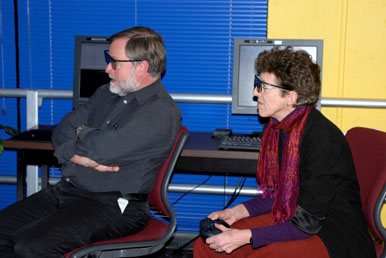Surfing the Surge
Global warming in virtual reality

It’s not every day you need a pair of 3-D glasses and a joystick to view an art exhibition. But to fully experience Surge, Deborah and Richard Cornell’s piece on global warming, you’ll need both of these tools, which allow you to climb inside their latest piece of cyberart and take a look around.
Surge, which debuted at the Boston Cyberarts Festival in late April, is an artistic representation of how climate change affects culture. The virtual sculpture invites viewers to navigate a three-dimensional spherical space using a video game controller. Along the way, they encounter and interact with ocean forms, social and environmental images, quotations from literary and science writers, and even acoustical elements.
“When you put a piece of art on the wall, people might spend two to three minutes with it, if you’re lucky,” says Deborah Cornell, a College of Fine Arts associate professor of visual arts. “But with the installation of virtual reality, people spend 20 to 30 minutes with it and ask questions afterward.”
“It speaks to its immersive quality,” says Richard Cornell, a CFA associate professor and chair of the theory and composition department.
Deborah Cornell, who conceived the visual components of Surge, says the city of Venice was the spark for the project. She has visited the historic city several times and has witnessed a sense of cultural loss among Venetians as they battle acqua alta, the flooding that has threatened the city’s infrastructure since the 1900s.
“All of my work is about the land, about change and time,” she says. “Global warming affects every bit of what I talk about in terms of art.”
In addition to the Venetian imagery, Cornell wove other images into the virtual space, such as Bradshaw figures, which are ancient Australian rock art paintings of humans, and four computer-generated lifeboats tattooed with either human chromosomes or diatoms, microscopic unicellular organisms that live in water and are a major food source for ocean life.
“Relationships between the images are experiential,” she says. “We grouped some of them together, others appear alone, and in between you’re just flying around in space and color.”
Richard Cornell added another element to the piece: acoustics. Approaching some of the images triggers specific sounds or pieces of music, such as thunder recorded in Chaco Canyon in New Mexico or a melancholy Schubert piano solo. Underneath all of it is the lulling sound of crashing waves on Cape Cod’s Nauset Beach.
“You’re creating the piece as you go through it,” Deborah says. “It’s interesting for us to see other people navigate through, what they see, what they’re interested in visiting, what they activate, what sorts of space they tend to dwell in. No one does it the same way twice.”
“It’s quite personal, actually,” says Richard.
Surge, a collaboration of the Cornells, the engineers at the University’s Scientific Computer and Visualization Group, and the Office of Information Technology, uses 24 projectors, 24 computers, at least 10 computer programs, software designed and implemented by the programming team at the University’s computer graphics lab, and a special 15-by-8-foot screen that appears as a three-dimensional world when viewed through special glasses.
“I hope there’s a realization of the fragility and the beauty of the environment and especially its close relationship to human culture, but that’s all underneath the surface,” says Deborah Cornell. “If they don’t get there, they don’t get there. The experience is what art is all about.”
To view Surge, call the Office of Information Technology at 617-353-2780 to make an appointment. The Cornells are planning another community viewing of Surge sometime this fall.
Nicole Laskowski can be reached at nicolel@bu.edu.